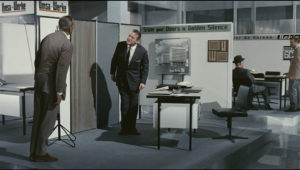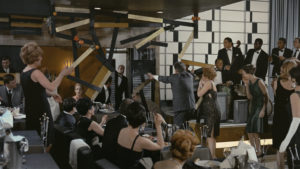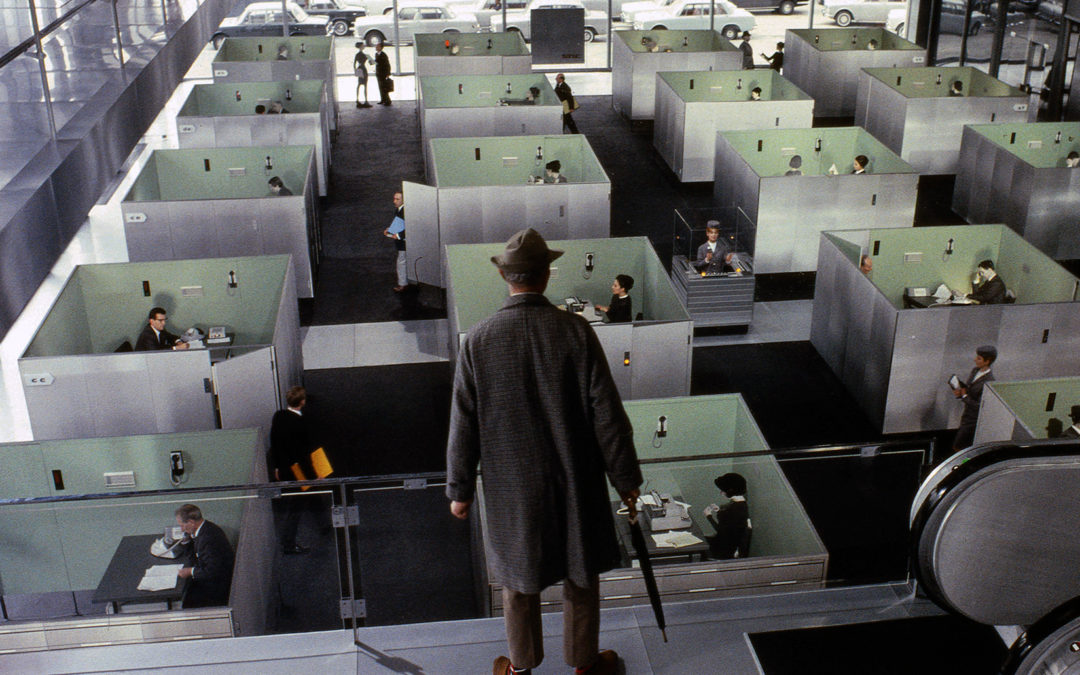As part of the younger generation that grew up alongside the 2000’s rapid advancements in technology, I can easily navigate my way through most technological mazes. Still, I’m sure at the rate technology is growing, I will eventually fall behind in my knowledge and the generation behind me will become the new tech wizards. Jacques Tati comments on this idea in his 1967 film Playtime by creating a vibrant, visual masterpiece portraying how it feels to fall behind in a once-familiar city that now feels foreign due to its advancing modernity. Tati kills two birds with one stone by directing and acting in Playtime as a character named Monsieur Hulot.
Tati was a man who cared deeply about detail, and due to that, most of his films took a few years to complete – one of which was Playtime, taking him three years to finish. He built the entire film set and even funded the film with his own money. The film achieved good ratings among film critics, but sadly, it was a failure with general audiences upon release. He eventually made his money back with his next and final feature film, Trafic (1971). Tati’s films fall into the genres of satire and comedy, even being considered as legendary as Buster Keaton comedies or Chaplin films. He acted in most of his movies as his signature character Hulot, adding an extra bit of personal flair, although Hulot wasn’t introduced until Tati’s second film, Le Vacances de Monsieur Hulot (1953). Playtime was also Tati’s second color film, but much of the movie seemed like it was shot in black and white. This is mainly due to the sleek, stylish objects featured, and the fact most buildings don’t usually come in all seven colors of the rainbow anyway. There is also the implication that modernity is bland with no originality. An American tourist named Barbra, played by Barbra Denneck, displays her disappointment during her tour when all there is to look at are giant skyscrapers. What she had really wanted to see were the old cobblestone roads and the beautiful Eiffel Tower.
I haven’t seen any of Tati’s other films, but I’ve read about them, and a common theme that seems to run through all of his movies is how convoluted and sometimes overly-paraded modern technology is made out to be. Especially in Playtime, it’s clear that the technology portrayed in the film is a little gimmicky. For instance, around the beginning of the film, Monsieur Hulot goes into a building where a man must telephone for someone to meet him – but it’s not your ordinary telephone. Instead, the phone is a whole wall full of buttons and switches. The wall-phone seemed to be normalized in the modern building, despite the porter’s confusion about why there must be that many buttons.

The porter and the wall-telephone.
Another scene in the film shows a sort of craft fair going on, and Hulot gets caught up in the endless network of cubicles. One business sells doors that don’t make a sound while closing – not even when slamming the door. While I suppose that idea could be handy if you have a newborn or light sleeper in the house, the concept also seemed a bit futile. Be that as it may, these were the inventions on the leading edge of technology and were thought to be “efficient” in the film. As per the silent door example, Playtime’s humor was slightly different from his other films. The humor wasn’t as explicit or purposely comical; the humor was more subtle and intuitive. Since Hulot seemed to be the only one who felt out of place in the city, the humor derives from understanding his point of view, consisting of confusion, disorientation, and a bit of curiosity.

M. Hulot (Jacques Tati) and the futile silent doors.
About a third of the way through the film, Hulot meets an old friend and they go into his friend’s new, modern apartment to have a drink, although Hulot keeps insisting he should leave. The scene doesn’t utilize actual conversation much and relies on voyeurism. Ninety percent of the film depends on voyeurism actually, and the conversations become part of the background noise. A smart move from Tati since the audience’s focus then shifts to the environment. The beautiful chaos in the film is similar to people skimming the pages in a Wheres Waldo? book, searching only for the tiny red-striped shirt and then moving on, except here, they miss all of the details of what’s going on around Waldo. Playtime has a lot to look at, but it’s worth the time to pay attention to every detail and re-watch scenes, if necessary, to scope out what everybody is doing. Many of the characters and actions seem perfectly choreographed but add to the idea that everything has a time and place in the film’s modern world.
Halfway through the film the plot switches to a fancy nightclub that just got finished with renovations – and I mean just got finished. In fact, they’re still putting the ladders away when the first guests arrive. Eventually, Hulot meets another old friend who invites him into the club as his special guest. Things go downhill from there: lights start to short out, outfits get ripped, dishes get over seasoned, the club goes from no air conditioning to too much air conditioning, the glass front door breaks, the drunkard at the bar keeps falling over, the band quits, and so much more. Keep in mind, all of this happens like it’s an average Tuesday night for the club. Even with the scene becoming increasingly complicated, each person was right on cue with their entrances or exits. There isn’t much to analyze in this scene and should be watched for pure enjoyment. I was awestruck by seeing all the loose ends come together and how organized Tati and his crew must have been to film such a scene of grandeur.

A mess of all sorts in the nightclub.
When I started this series, many of the films were from directors Truffaut or Godard, but as each issue progresses towards the end, it’s clear we have analyzed so many different films, each with unfettered, prolific styles and ideas. Playtime, A Modern Coed, and The Umbrellas of Cherbourg are very different than The Fire Within, Hiroshima mon Amour, and Purple Noon, yet each of them, individually, are also very different from each other. This boundless creativity from The French New Wave inspired new generations of filmmakers, especially in Germany, where a new movement called The New German Cinema arose around 1962. In the ’60s, the country was still decades away from the Berlin Wall falling, there was a lull in cultural activity, and German cinema was failing, but the New German Cinema movement helped revive some of its downtrodden culture. Like many films by Godard that portrayed radical political messages, or even the simple messages of how society is changing like in Playtime, New German Cinema strived for a new lineage of filmmaking. It differed from traditional techniques and showed each director’s political stance or brought light to contemporary issues. In fact, one could say New German Cinema was like the little brother to The French New Wave. The French film movement was so powerful that it inspired other countries to start their own film movements and was full of diverse films from Truffaut to Tati or Chabrol; each director truly having a lasting impact on cinema.


Recent Comments